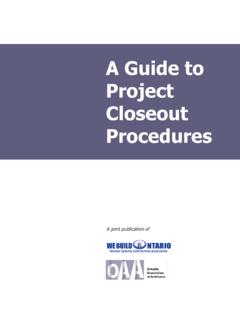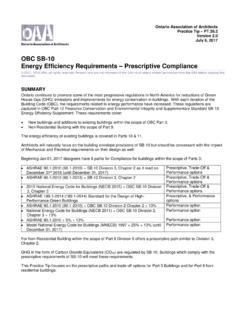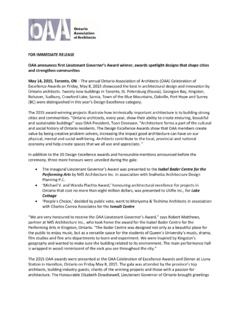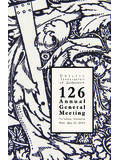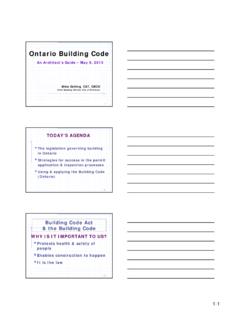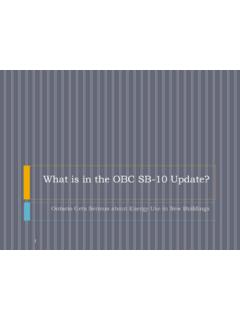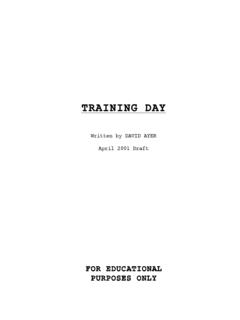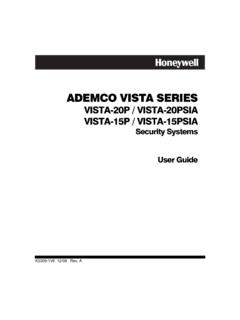Transcription of Ontario Building Code: Egress and Exiting
1 Ontario Building code : Egress and Exiting Judy Jeske Principal; Director of code and Life Safety Group Senior code Specialist 613-739-3251. Terminology Egress Access to exit Exit Means of Egress Exit discharge Exit level Exit storey 2. Outline 1. OBC terminology 3. 1. code Requirements? Stair design Steps Ramps Travel distance Number of exits Width Door swing Guard design Handrail design Hardware 4. code Requirements? Fire separation Exit signs Lighting Pull stations Barrier-free Refuge area . 5. Outline 1. OBC terminology 2. code provisions 6. 2. Origin? History Principles Fundamentals 7. Outline 1. OBC terminology 2. code provisions 3. Factors influencing Egress and exit design 8. Design Options Options? Exits . (a) exterior doorway, (b) exterior passageway, (c) exterior ramp, (d) exterior stairway, (e) fire escape (f) horizontal exit, (g) interior passageway, (h) interior ramp, or (i) interior stairway. 9. 3. Outline 1. OBC terminology 2. code provisions 3. Factors influencing Egress and exit design 4.
2 Design options 10. New to 2014. Future? New exit signs Elevators as exits ? 11. Outline 1. OBC terminology 2. code provisions 3. Factors influencing Egress and exit design 4. Design options 5. New for 2014. 12. 4. Outline 1. OBC terminology 2. code provisions 3. Factors influencing Egress and exit design 4. Design Options 5. New for 2014. 13. Outline 1. Factors influencing Egress and exit design 2. OBC terminology 3. code provisions 4. Design options 5. New for 2014. 14. Factors Influencing Egress and Exit Design History Large fires Response from fire protection community Egress time line Human behaviour Safe conditions OBC Objectives 15. 5. Factors Influencing Egress and Exit Design History of Codes and Egress design Knowledge comes from: Experience Research 16. Triangle Shirtwaist Factory, NYC, 1911. 8th, 9th, and 10th floors;. 500 employees Fire origin: bin of rags on 8th floor Large quantities of fabric 8th floor: one exit locked, when unlocked, swung against direction of exit travel 10th floor occupants: escaped to roof and then across to an adjacent buidling 9th floor ocupnats: not warned, exterior fire escape collapsed (fire exposure).
3 17. Triangle Shirtwaist Factory, NYC 1911. 147 persons died Contributing factors: Noncombustible construction required for Building >150 ft tall, Building was only 135', combustible constriction 3 exits required, 2 interior provided plus exterior fire escape Results: Commissions and investigations New York City Fire Prevention Bureau (first in US). NFPA expanded application to include life safety 18. 6. Centre Block, Ottawa 1916. Date: Feb 3, 1916. Origin wastebasket in Reading Room, wood paneled and paper filled room House of Commons had to be evacuated Some women attempted to reclaim their fur coats Human chain to carry furniture, files and artwork Building destroyed in 12 hours Library of Parliament saved 7 people died 19. Cocoanut Grove Nightclub Fire, Boston, 1942. Designed for 600. Actual 1000 persons One storey plus basement Fire: basement wall finishes Basement: One exit from basement to ground Ground floor: One other exit at ground floor locked Main exit was revolving doors Ground floor occupants (dining room) only familiar with the main entrance, Adjacent lounge, exit door swung against direction of travel 20.
4 Cocoanut Grove Nightclub Fire 492 persons died Contributing factors: Exceeded occupant load Combustible finishes Exits hidden or locked Results: Led to modern exit capacity calculations New requirements for loose seating in assembly occupancies Exit lighting requirements 21. 7. World Trade Centre Bombing, NYC, 1993. 1000 lb bomb on B2 level Impacted fire and life safety systems 240 elevators out of service Impact on firefighter access 6 people died, 1042 injured 22. World Trade Centre Bombing, NYC, 1993. Results: 1598 person survey to fire safety organization >25% response Ave. start of evacuation: 5 minutes Previous fire drill experience was not considered adequate Other studies: Stairwells movement 23. World Trade Centre Bombing, NYC, 1993. 24. 8. Kiss Nightclub, Santa Maria, Brazil January 27, 2013. 241 killed, at least 168 injured Origin: Insulation foam caught fire when singer of a band held a firework close to the ceiling Only one exit door. Escape routes and lighting found to be inadequate Licensed for 800; Actual 1000 persons 2nd most devastating fire in Brazil after the Great North American Circus fire (Dec 1961) (503 killed).
5 25. Kiss Nightclub, Santa Maria, Brazil At least 180 bodies removed from washrooms Many injured by crush at front door Security guards apparently held people inside Most deaths from smoke inhalation Some from burns 26. Factors Influencing Egress and Exit Design Triangle shirtwaist Factory 2011. Centre Block Parliament Hill 1916. Cocoanut Grove Nightclub 1942. Ringling Brothers Circus 1944. Beverly Hills Supper Club 1977. MGM Grand Hotel 1980. 2 Forest Lane Toronto 1995. WTC Bombing 1993. WTC Collapse 2001. Station Nightclub 2003. Cook County Administration Building 2003. 27. 9. Factors Influencing Egress and Exit Design History Large loss fires Response from fire protection community Egress time line Human behaviour Safe conditions OBC Objectives 28. Factors Influencing Egress and Exit Design code perspective: Evacuation Emergency evacuation Two components to evacuation time 1. Before we start to move Pre-movement time 2. Travel time 29. Factors Influencing Egress and Exit Design 30.
6 10. Factors Influencing Egress and Exit Design Pre-movement time (from time 0 to start of movement). Also called delay time A few seconds to several minutes Influenced by: Effectiveness of fire cues Effectiveness of training Time of day, weather etc. 31. Factors Influencing Egress and Exit Design Pre-movement time Time to notification Reaction time Pre-evacuation activity time Travel or movement time 32. Factors Influencing Egress and Exit Design Time to notification Time 0: time when ignition occurs to: time that alarm sounds or people sense the fire cues 33. 11. Factors Influencing Egress and Exit Design Non-fire alarm cues: Sight or smell of smoke Heat Sight of flames Sound of glass breaking We can estimate time to notification Through calculation Experimental data Time to notification can be very long 34. Factors Influencing Egress and Exit Design Shorten by selection of the right detection system Ionization versus photoelectric smoke detectors Sprinkler systems (response time index).
7 Placement of devices Polling and computing time within fire alarm systems No fire alarm system? Best detector? Awake and alert persons are the best detector 35. Factors Influencing Egress and Exit Design Reaction time Time for an occupant to perceive the alarm or fire cue and decide to take action Wake up Identify the sounds, smells or other Recognize a fire alarm signal Decide to leave 36. 12. Factors Influencing Egress and Exit Design Alertness intoxication Age young and elderly Level of training influences decision to leave Familiarity with surroundings Commitment to a task Airport Lecture environment 37. Factors Influencing Egress and Exit Design Response to alarm sounds Old bell style sound versus temporal pattern Recognition of sound plus sense of urgency Audibility Signal only or signal plus voice Intelligibility of voice 38. Factors Influencing Egress and Exit Design Pre-Evacuation Activity Time Elapsed time while an occupant prepares to leave Dwelling units: dress, gather children, valuables Hotel occupants: pack or gather valuables Office: shut off equipment, lock files, grab coat or purse Industrial: safe shut down of equipment Could also be a person ignoring an alarm result of nuisance alarms 39.
8 13. Factors Influencing Egress and Exit Design Longer pre-movement time; more efficient that Egress systems have to be 40. Factors Influencing Egress and Exit Design Travel time Time to travel to place of safety Architectural design has influence 41. Factors Influencing Egress and Exit Design Influences on travel speeds Number of people Width Level of lighting Moving through smoke Movement around obstructions/through doors Handrails within easy reach on stairs/ramps Roughness of wall surfaces Riser height and tread depth 42. 14. Factors Influencing Egress and Exit Design Number of people 43. Factors Influencing Egress and Exit Design Width affects capacity Can create queuing Flow constraint Fc = Fs We Where Fc: Flow rate at exit door (persons/s). Fs: Specific flow (persons/s/m) We: Effective width (m). 44. Factors Influencing Egress and Exit Design Moving through smoke 45. 15. Factors Influencing Egress and Exit Design 46. Factors Influencing Egress and Exit Design Stair rise and run 47.
9 Factors Influencing Egress and Exit Design 48. 16. Factors Influencing Egress and Exit Design Travel speed Different people move at different speeds ( , children, people with disabilities, etc.). Unimpeded on flat surface: m/s Unimpeded on stairs: to m/s 49. Factors Influencing Egress and Exit Design History Large loss fires Response from fire protection community Egress time line Human behavior Safe conditions OBC Objectives 50. Factors Influencing Egress and Exit Design Decisions during the pre-movement time UK versus NA results UK: 1st action to fight the fire NA: 1st action to notify others Women versus men Women: got family and leave Building Men: investigate fire 51. 17. Factors Influencing Egress and Exit Design Decision to leave . Commitment 52. Factors Influencing Egress and Exit Design Commitment to task . Airport environments Paid events Waiting in line 53. Factors Influencing Egress and Exit Design Decision to leave . Commitment Familiarity 54. 18. Factors Influencing Egress and Exit Design Station Nightclub fire, Rhode Island 100 people died 11:07 PM, 2003.
10 Packed club with live band Pyrotechnics ignited foamed plastic wall linings Urethane and polyethylene foam 55. Factors Influencing Egress and Exit Design Flames thought to be part of the act Band played for 20 seconds while fire engulfed set Event was being filmed, cameraman continued to film Most people tried to exit the way they had come in 56. Factors Influencing Egress and Exit Design Office environment What do you do if the fire alarm goes off while you are in a hotel? 57. 19. Factors Influencing Egress and Exit Design Decision to leave . Commitment Familiarity Training Taking the lead versus waiting for others to make the first move (lemming effect). Reliability of fire alarm 58. Factors Influencing Egress and Exit Design Training Know location of exits Recognize alarm signal Know what to do Trained staff can give effective direction . 59. Factors Influencing Egress and Exit Design Choice of exit? Which exit will you chose? If doors are front of you? In front If doors behind?
